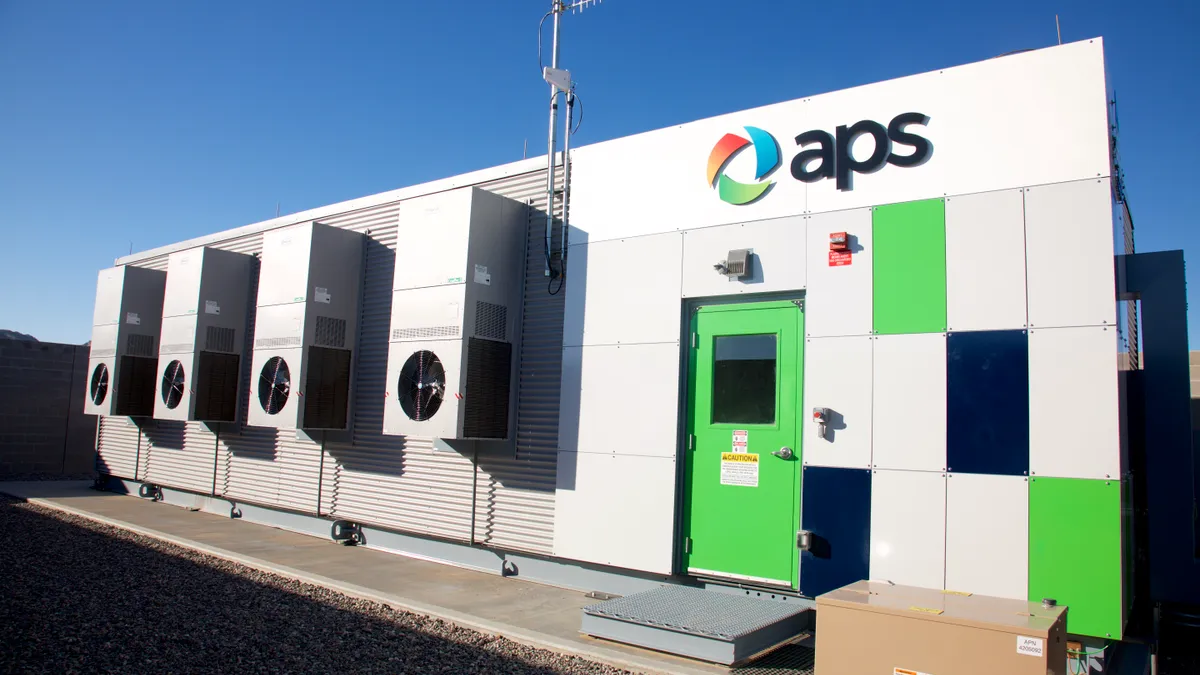Dive Brief:
-
Arizona Public Service (APS) will install 850 MW of energy storage by the mid-2020s, the utility announced Thursday, including 450 MW / 1500 MWh that will come online by 2021 and an additional 400 MW slated for 2025.
-
By 2021, APS will install 200 MW / 600 MWh of energy storage as retrofits to existing solar facilities, 150 MW / 300 MWh of standalone batteries and a new 100 MW solar facility paired with a 100 MW / 300 MWh battery system. Additionally, the utility will add 400 MW of storage with three- or four-hour durations that will be online by 2025.
-
The utility also signed a seven-year power purchase agreement (PPA) for a 463 MW natural gas plant owned by Calpine. The short contract will allow the utility to potentially replace power from the plant with clean resources in the mid-2020s, APS Director of Resources Planning Jeff Burke told Utility Dive.
Dive Insight:
Taken together, the new APS storage plans unveiled Thursday amount to one of the largest battery storage procurement announcements in U.S. history.
Last summer, Pacific Gas and Electric said it would seek approval for three storage projects totaling 567.5 MW / 2,270 MWh, the largest single-day announcement to that point.
The APS statement already outpaces that record in terms of megawatts and could eclipse the duration of the California facilities if the utility chooses three- or four-hour batteries for its remaining 400 MW of storage.
Those facilities will be built to fill upcoming requests for proposals (RFPs) that will be issued by APS, Burke said. Their duration will depend on which types of projects rise to the top in those solicitations.
"What we don't know is how long the duration will be of the other remaining batteries because they could be [standalone] batteries, they could be [PV-paired storage]," he said. "Between three and four hours is what we're expecting."
Those facilities will be online by the middle of next decade. By that time, APS will have 1,500 MWh of new batteries shifting solar generation from the midday to evening.
A first tranche will come as upgrades to existing solar facilities in Maricopa County and Yuma that are part of the utility’s AZ Sun program. By 2020, a team led by Invenergy will install about 140 MW / 420 MWh of storage spread across six sites, after which APS will add an additional 60 MW / 180 MWh of storage to other facilities.
APS had originally planned for only 100 MW of storage upgrades to the AZ Sun facilities, Burke said, but "we got the bids back and we thought that they looked pretty good, and so … we decided to expand that program."
In addition to the new RFP and AZ Sun retrofits, APS will add 150 MW of standalone batteries with four hour durations by 2021. AES will contribute a 100 MW / 400 MWh project while Invenergy will build a 50 MW / 200 MWh facility.
Those projects come in response to an April 2018 RFP that sought 400 MW to 800 MW of peaking generation capacity that could be delivered between 3:00 p.m. and 9:00 p.m., when APS electricity demand is highest.
The RFP initially caused some controversy in renewable energy circles for designating that at least half of the capacity come from new natural gas-fired facilities, which APS said was necessary to ensure "reliability" and "diversity" of its energy supply.
Accordingly, APS selected a 463 MW gas plant contract as part of the solicitation. Burke said that generation was competitive with batteries because it comes from an existing facility, rather than a new plant, which APS was prohibited to build due to a continuing moratorium on building new gas generation in Arizona.
The contract with the Calpine plant is only for seven years, far shorter than the more typical 20-year PPA duration. Burke said that could allow APS to replace the carbon-emitting power with renewable resources and batteries when the deal expires.
"That’s our hope, that’s what we want to see," he said. "Within the region there were a number of existing merchant [gas] plants and so we have signed those up to shorter term deals, knowing the technology is improving and knowing that we're going to give ourselves an option as the prices improve, as technology gets a little bit more advanced."
The new APS storage plans appear to show an increasing familiarity and confidence with battery technology. Last May, during the controversy over the peaking RFP, Burke said APS could not fill the entire 800 MW solicitation with storage resources because it had to "get comfortable" with the technology.
"We've only seen 500 MW to 700 MW [of long-duration storage] across the U.S.," Burke said at the time. "Do you expect us to put 500 MW of solar-plus-battery as the only resource through this RFP? I think that could challenge reliability."
The new facilities will not be APS's first, however. The utility last year announced it would add a 50 MW, 135 MWh battery to an existing solar facility, and APS is also planning a smaller, 8 MWh battery to defer a transmission investment outside Phoenix.













